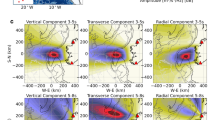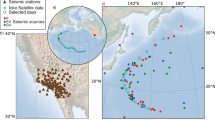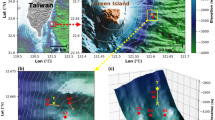Abstract
The attenuation of ionospheric signals in the frequency range 0.06–24 Hz by sea water effectively precludes using the magnetotel-luric method to study the electrical structure of the upper oceanic lithosphere. We have carried out a dipole–dipole electromagnetic sounding in the North Pacific by injecting electromagnetic signals into the ocean and sea bed. The crust at the site is 25 Myr old and has a thin sediment cover. The technique, similar to that used in earlier work1,2, involves dragging a horizontal dipole antenna along the sea floor. The electric fields that propagated through the resistive basement were detected by seafloor receivers at ranges of 10–65 km. As the ambient electric field is very small (varying from 10−18 V2 m−2 Hz−1 at 0.1 Hz to 10−24 V2 m2 Hz−1 above 1 Hz; ref. 3), the controlled-source signals could be easily monitored. Our data are consistent with a simple one-dimensional Earth model consisting of a 3–7-km-thick crustal layer of moderate conductivity (∼0.001 S m−1) underlain by a thicker region of very low conductivity (<2 × 10−5 S m−1). The results suggest an upper mantle water content of at most 0.1% by volume.
This is a preview of subscription content, access via your institution
Access options
Subscribe to this journal
Receive 51 print issues and online access
$199.00 per year
only $3.90 per issue
Buy this article
- Purchase on Springer Link
- Instant access to full article PDF
Prices may be subject to local taxes which are calculated during checkout
Similar content being viewed by others
References
Spiess, F. N. et al. Science 207, 1421–1433 (1980).
Young, P. D. & Cox, C. S. Geophys. Res. Lett. 8, 1043–1046 (1981).
Webb, S. C. & Cox, C. S. Geophys. Res. Lett. 11, 967–970 (1984).
Webb, S. C., Constable, S. C., Cox, C. S. & Deaton, T. K. J. Geomagn. Geoelectr. (in the press).
Chave, A. D. & Cox, C. S. J. geophys. Res. 87, 5327–5338 (1982).
Marquardt, D. W. J. Soc. ind. appl. Math. 11, 431–441 (1963).
Shor, G. G. Jr, Jr Menard, H. W. & Raitt, R. W. in The Sea Vol. 4, Pt 2 (ed. Maxwell, A. E.) 3–27 (Wiley, New York, 1970).
Brace, W. F. Am. geophys. Un. Monogr. 14, 243–260 (1971).
Quist, A. S. & Marshall, W. L. J. phys. Chem. 71, 684–703 (1968).
Gregory, R. T. & Taylor, H. P. J. geophys. Res. 86, 2737–2755 (1981).
Klitgord, K. G. & Mammerickx, J. J. geophys. Res. 87, 6725–6750 (1982).
Parsons, B. & Sclater, J. G. J. geophys. Res. 82, 803–821 (1977).
Rai, C. S. & Manghnani, M., Phys. Earth planet. Inter. 17, 6–13 (1978).
Duba, A., Heard, H. C. & Schock, R. N. J. geophys. Res. 79, 1667–1673 (1974).
Shankland, B. & Waff, H. S. J. geophys. Res. 82, 5409–5417 (1977).
Author information
Authors and Affiliations
Rights and permissions
About this article
Cite this article
Cox, C., Constable, S., Chave, A. et al. Controlled-source electromagnetic sounding of the oceanic lithosphere. Nature 320, 52–54 (1986). https://doi.org/10.1038/320052a0
Received:
Accepted:
Issue Date:
DOI: https://doi.org/10.1038/320052a0
This article is cited by
-
Fluid transport and storage in the Cascadia forearc influenced by overriding plate lithology
Nature Geoscience (2022)
-
Inverted long-baseline acoustic navigation of deep-towed CSEM transmitters and receivers
Marine Geophysical Research (2021)
-
3-D Adaptive Finite-Element Modeling of Marine Controlled-Source Electromagnetics with Seafloor Topography Based on Secondary Potentials
Pure and Applied Geophysics (2018)
-
Electrical conductivity of old oceanic mantle in the northwestern Pacific I: 1-D profiles suggesting differences in thermal structure not predictable from a plate cooling model
Earth, Planets and Space (2017)
-
Accurate Interpolation at Receiver Positions: A Novel Method for Frequency-Domain Marine CSEM Finite-Difference Modelling
Pure and Applied Geophysics (2017)
Comments
By submitting a comment you agree to abide by our Terms and Community Guidelines. If you find something abusive or that does not comply with our terms or guidelines please flag it as inappropriate.



